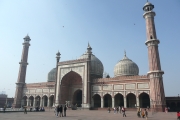
Delhi
Culture (temples, places of pilgrimage, spirituality, mythology, Hinduism), yoga, wildlife parks, mountains
The Indian capital pleasantly surprises, with temples, mosques, forts, colonial buildings and densely populated street scenes. The metropolis consists of two different urban areas: Old Delhi and New Delhi. This distinction makes it easier for visitors to orient themselves. Built in the first half of the 17th century, Old Delhi served as the capital of the Mughal dynasty and is dotted with forts and mosques, such as the Red Fort, and the Jama Masjid. New Delhi is characterized by wide streets and embedded parks and was established in 1911 as the capital by the British.
Red Fort or Lal Quila
This massive fort was built in ten years during the reign of Mughal Emperor Shah Jahan (17th century) in connection with the intention of moving the capital from Agra to Delhi. The complex includes halls for public and private audiences, a mosque and elaborately designed gardens. The water for the 10 m deep moat on the eastern side of the fort was once supplied by the Yamuna River, which runs about a kilometer away today. Interesting to visitors is the nightly “Sound and Light Show” with spotlights illuminating the palace and highlighting historical events, especially from the Mughal period.
Jama Masjid
 The Jama Masjid, the largest mosque in India, was also built by Mughal Emperor Shah Jahan. Located on a hill, it forms a prominent center for the surrounding markets. A broad flight of steps leads to imposing gates, behind which is an impressive courtyard. Mighty domes adorn the large prayer hall on the western side. At the corners of the courtyard are slender minarets, from which one has a unique view of both Old Delhi and New Delhi.
The Jama Masjid, the largest mosque in India, was also built by Mughal Emperor Shah Jahan. Located on a hill, it forms a prominent center for the surrounding markets. A broad flight of steps leads to imposing gates, behind which is an impressive courtyard. Mighty domes adorn the large prayer hall on the western side. At the corners of the courtyard are slender minarets, from which one has a unique view of both Old Delhi and New Delhi.
Hauz Khas
The name Hauz Khas means “Royal Basin”. In the 14th century, it was the center of Siri, the second capital, built on lands that were to become modern Delhi. The large Ala-ud-din Khaljis water tank is located here, a reservoir through which the early inhabitants of Siri were supplied with water. 50 years later, Firoz Khan added a two-storey madrassa and a mosque to the facility. Next to this complex is the grave of Firoz Khan, known for his exquisite Islamic architecture, permeated by elements of Indian tradition.
Connaught place
 At the center of New Delhi is Connaught Place, a large roundabout bordered by the ground floor arcades of the two-storey buildings that run alongside it. This commercial center hosts shops, banks, restaurants and airline offices. Connaught Place is also an important point of orientation in the metropolis.
At the center of New Delhi is Connaught Place, a large roundabout bordered by the ground floor arcades of the two-storey buildings that run alongside it. This commercial center hosts shops, banks, restaurants and airline offices. Connaught Place is also an important point of orientation in the metropolis.
Jantar Mantar
Jantar Mantar, near Connaught Place, is an open air observatory, developed in 1725 by Maharaja Jai Singh II, the astronomer and ruler of Jaipur, for Mughal Emperor Muhammad Shah. Large stone structures were used to determine the time of day and to calculate solar and lunar calendars and planetary movements.
